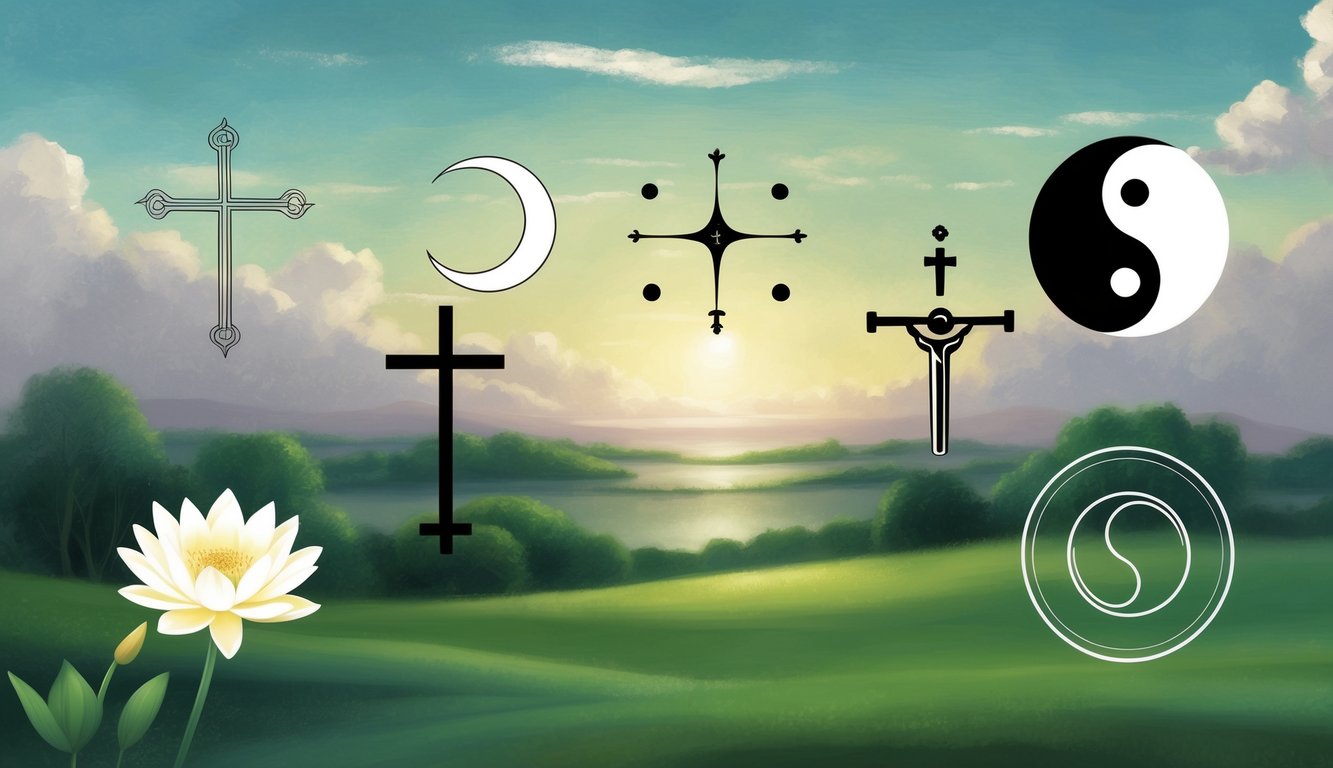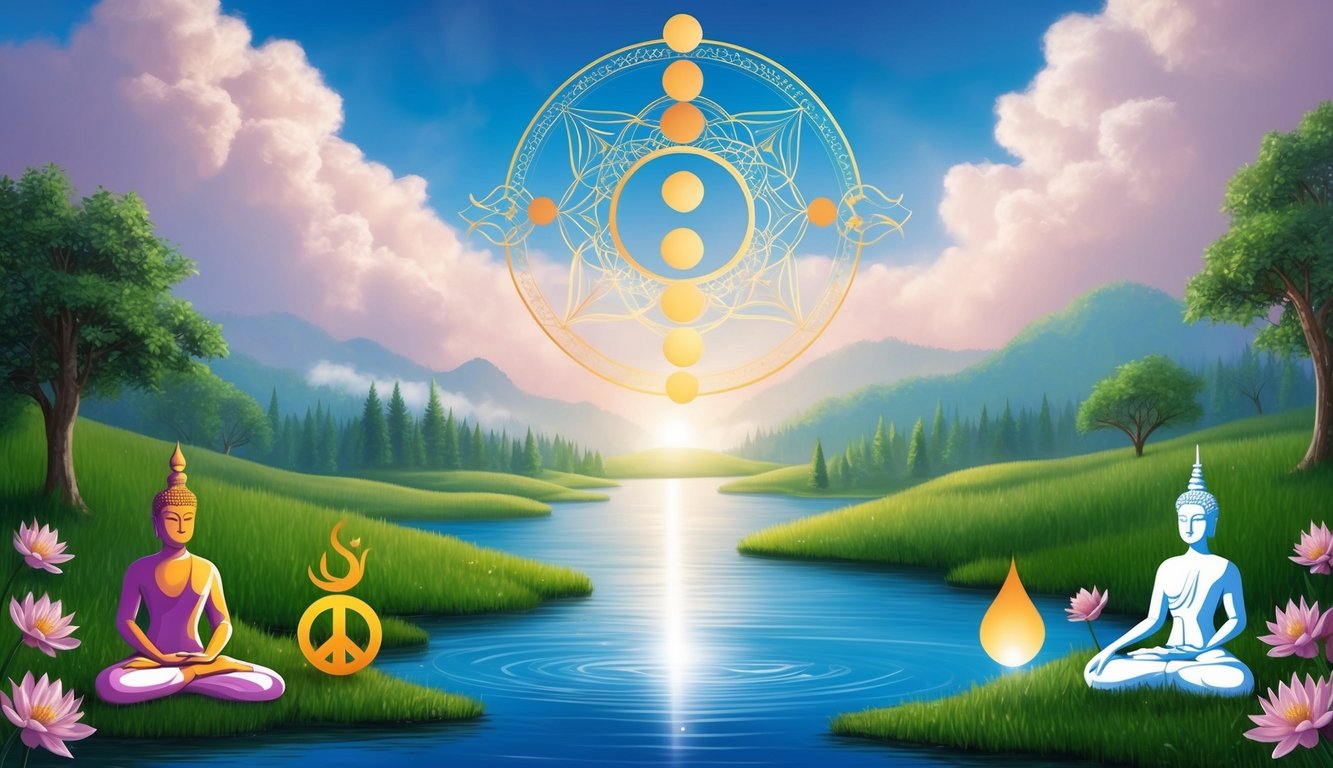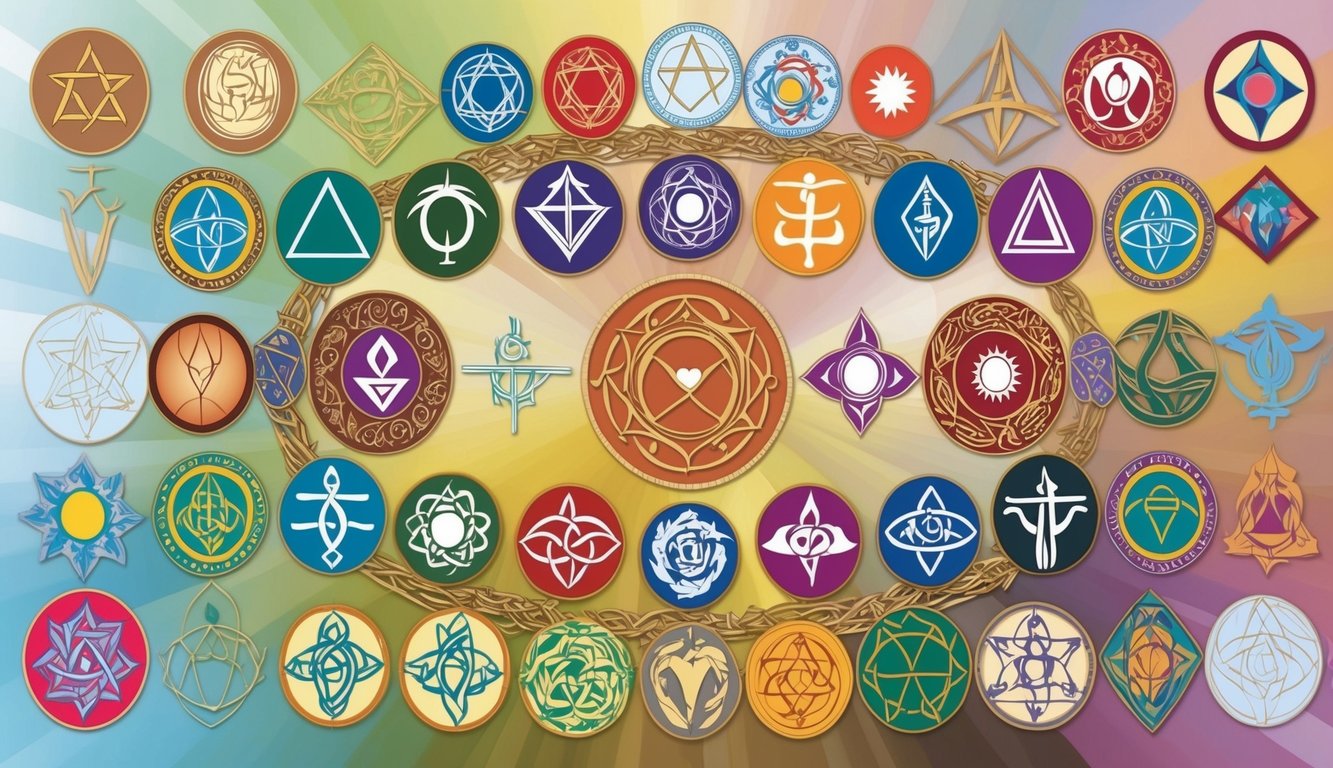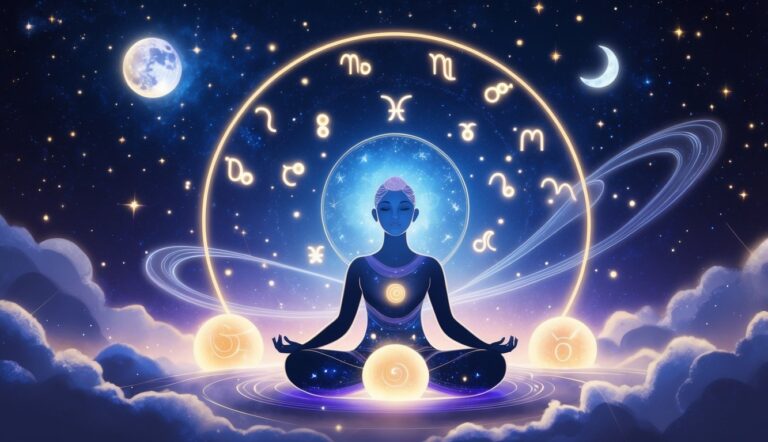Align Your Life with Your True North
The Power Quadrant System decodes your natural talents and pinpoints the career, timing and relationships that let you earn more, love deeper, and wake up eager for the day.
- Uncover your #1 high-income strength
- Draw in partners who raise your energy
- Work when your body’s clock is in “flow”
Ever felt lost in the sea of spiritual jargon? You’re not alone.
Spirituality can seem like a whole new language, with terms and concepts that might leave you scratching your head.
But don’t worry, we’ve got you covered.
A spirituality glossary is your handy guide to decoding the mystical world. It’s a collection of terms and their meanings, helping you navigate everything from ancient practices to modern spiritual concepts. Whether you’re curious about alchemy, pondering the afterlife, or exploring kundalini energy, a good glossary can be your trusty companion.
Diving into spirituality doesn’t have to be overwhelming.
With a glossary at your fingertips, you can explore new ideas, understand different traditions, and deepen your spiritual journey.
It’s like having a friendly translator, making the complex world of spirituality accessible and exciting.
Ready to expand your spiritual vocabulary?
The AngelWisdom Spiritual Glossary
Astral Body
A subtle body believed to exist between the physical and spiritual realms, often experienced during astral travel.
Affirmation
Positive statements or phrases used to reprogram thoughts and beliefs, enhancing spiritual growth and self-love.
Alignment
The state of being in harmony with one’s spiritual beliefs and purpose, creating balance in life.
Ancestral Healing
A spiritual practice focused on healing inherited trauma or patterns passed down from ancestors.
Decode Your Personal Success Blueprint
Power Quadrant System shows you the exact career, relationships, and daily rhythm that match your natural DNA—so you earn more, work happier, and connect deeper.
- Pinpoint your #1 money-making talent
- Erase conflict & attract ideal partners
- Multiply productivity with perfect timing
Ascended Masters
Spiritually enlightened beings believed to guide humanity from higher planes of consciousness.
Atman
A Sanskrit term for the soul or inner self, central to many Hindu and spiritual beliefs.
Aura
An energy field that surrounds living beings, reflecting their emotional and spiritual state.
Awakening
The process of becoming aware of one’s true spiritual nature and connection to the universe.
Balance
A harmonious state achieved when mind, body, and spirit are aligned and in sync.
Bliss
A profound state of joy and spiritual fulfillment often experienced during deep meditation or connection with the divine.
Breathwork
Various breathing techniques used to enhance spiritual connection, release emotions, and promote healing.
Chakra
Energy centers in the body that correspond to different physical, emotional, and spiritual functions.
Channeling
The practice of receiving spiritual messages or guidance from non-physical beings or higher consciousness.
Tap Into Your Built-In Success GPS
The Power Quadrant System deciphers your genetic blueprint so you can lock onto the career, income and relationships that feel effortless—and wildly rewarding.
- Zero in on your natural high-earning genius
- Sync with partners who boost your vibe
- Wake up driven, finish days fulfilled
Clairvoyance
The ability to gain information about people, objects, or events beyond normal human senses.
Consciousness
The state of awareness and perception, seen as the essence of spiritual growth and evolution.
Crystal Healing
A spiritual practice using crystals to balance energies and promote physical, emotional, and spiritual healing.
Dharma
A concept in Hinduism and Buddhism representing one’s duty, moral responsibility, or spiritual path.
Divine
Referring to a higher power, source of creation, or universal consciousness.
Divination
The practice of seeking knowledge of the future or unknown through spiritual means, like tarot or astrology.
Duality
The existence of two contrasting principles (such as light and dark) believed to create balance in the universe.
Energy Healing
A healing technique that uses energy fields to restore balance to the body, mind, and spirit.
Enlightenment
The state of ultimate spiritual understanding and freedom from the cycle of rebirth.
Esoteric
Knowledge or teachings meant to be understood by a select group, often related to spirituality or mysticism.
Essential Oils
Natural plant extracts used for healing, cleansing, and enhancing spiritual practices.
Faith
A deep belief or trust in the divine or a higher power guiding one’s life and purpose.
Frequency
The vibration or energy level that a person or object emits, influencing spiritual and emotional states.
Guru
A spiritual teacher or guide who helps individuals on their path to enlightenment.
Higher Self
The spiritual aspect of oneself that is connected to universal consciousness.
Holistic
An approach considering mind, body, and spirit as interconnected aspects of health and spirituality.
Intention
A conscious aim or purpose set to guide spiritual growth or manifest specific outcomes.
Intuition
Inner knowing or guidance that transcends logical reasoning, often perceived as a spiritual insight.
Karma
The principle that one’s actions in life will affect their future experiences, based on cause and effect.
Lightworker
An individual who feels a strong calling to bring positivity and healing to others.
Manifestation
The practice of bringing desired outcomes into reality through focused thought, belief, and action.
Mantra
A word or phrase used in meditation to focus the mind and foster spiritual connection.
Mindfulness
The practice of maintaining awareness in the present moment, often used in spiritual and meditative practices.
Mysticism
A spiritual belief in the possibility of direct experience of the divine or ultimate truth.
Namaste
A greeting in Sanskrit meaning “I bow to the divine in you,” often used in yoga and spiritual contexts.
Om
A sacred sound representing the essence of the universe, frequently used in meditation and chanting.
Oneness
The spiritual concept that all beings are interconnected and part of a unified whole.
Oracle
A person or tool used to communicate spiritual or divine messages, often through symbolic language.
Past Life Regression
A technique used to explore one’s past incarnations, often for spiritual healing or understanding.
Prana
The life force energy that flows through all living things, similar to chi in Chinese spirituality.
Presence
The quality of fully engaging in the present moment, central to mindfulness and spiritual awareness.
Qi (Chi)
A concept in Chinese spirituality representing life energy that flows through all living things.
Reiki
A Japanese technique for stress reduction and relaxation that promotes healing through energy transfer.
Reincarnation
The belief that the soul is reborn into new bodies over successive lifetimes.
Resonance
The phenomenon where frequencies align, often creating harmony between energies or individuals.
Retreat
A spiritual practice of withdrawing from daily life for reflection, meditation, and self-discovery.
Sacred Geometry
Geometric patterns found in nature that represent universal truths and harmony.
Sage
An herb used for cleansing and purifying spaces and individuals in spiritual rituals.
Samadhi
A state of deep meditation leading to spiritual absorption and enlightenment.
Self-Realization
The awareness of one’s true nature beyond physical and mental limitations.
Shadow Work
The practice of exploring and integrating repressed or hidden parts of the psyche for self-healing.
Shamanism
A practice involving a connection to nature and spiritual realms, often led by a shaman who guides others.
Soul
The immortal essence or spiritual core of a being, central to many religious and spiritual beliefs.
Spirit Guide
A non-physical being believed to guide, protect, or advise individuals on their spiritual journey.
Spiritual Awakening
A profound shift in perception that reveals deeper understanding and connection with the universe.
Surrender
The act of letting go of control and trusting in a higher power or the universe’s guidance.
Synchronicity
The occurrence of meaningful coincidences that seem to have a deeper significance in one’s spiritual journey.
Tantra
A spiritual practice that emphasizes the union of opposites and the integration of all aspects of life.
Tao
The fundamental nature of the universe in Taoism, representing balance and harmony with natural order.
Third Eye
The spiritual center of intuition and insight, often associated with the sixth chakra located between the eyebrows.
Transcendence
The experience of going beyond ordinary limits, reaching higher states of awareness or consciousness.
Unity
The state of being one with all existence, often a goal in spiritual practices that emphasize oneness.
Vibration
The frequency at which one’s energy resonates, affecting and attracting similar energies.
Visualization
The practice of using mental images to manifest desired outcomes or connect with spiritual energies.
Yin and Yang
Chinese philosophical concept describing how opposite forces are interconnected and balanced within the universe.
Zen
A form of Buddhism that emphasizes meditation and intuition over ritual, focusing on direct experience.
Understanding Spirituality
Spirituality encompasses personal beliefs, practices, and experiences that connect you to something greater than yourself.
It often involves seeking meaning, purpose, and transcendence in life.
Defining Spirituality
Spirituality is a broad concept that means different things to different people.
At its core, it’s about your inner search for purpose and connection to the world around you.
It can involve religious beliefs, but doesn’t have to.
Spirituality often includes:
- A sense of interconnectedness with others and nature
- Contemplation of life’s big questions
- Personal growth and self-discovery
- Practices like meditation, prayer, or rituals
Your spiritual path is unique to you.
It may evolve as you gain new experiences and insights throughout your life.
Historical Context
Spirituality has ancient roots in human civilization.
Early spiritual practices often centered around nature worship and animism.
As societies developed, more complex belief systems emerged.
Major world religions like Buddhism, Hinduism, Judaism, Christianity, and Islam shaped spiritual thought for centuries.
These traditions offered frameworks for understanding existence and connecting with the divine.
Indigenous cultures worldwide maintained their own rich spiritual traditions, often emphasizing harmony with nature and ancestral wisdom.
Throughout history, mystics and philosophers have explored spirituality outside of organized religion.
Their teachings have influenced spiritual seekers across cultures.
Modern Perspectives
Today’s spirituality is diverse and often personalized.
Many people mix elements from different traditions to create their own spiritual practice.
Key aspects of modern spirituality include:
- Mindfulness and meditation
- Energy healing practices like Reiki
- New Age beliefs and philosophies
- Psychedelic experiences for spiritual growth
- Scientific exploration of consciousness
You might find spirituality through traditional religious paths or secular practices focused on personal growth.
The internet has made spiritual teachings from around the world more accessible than ever.
Your spiritual journey can involve exploring various perspectives to find what resonates with you.
It’s about discovering practices and beliefs that bring meaning and fulfillment to your life.
Spiritual Practices

Spiritual practices form the core of many traditions, offering paths to inner growth and connection.
These methods range from introspective techniques to communal rituals, each designed to deepen one’s spiritual journey.
Meditation and Mindfulness
Meditation involves focusing your attention to achieve mental clarity and emotional calm.
You might start with simple breath awareness, counting inhales and exhales.
As you progress, try guided visualizations or mantra repetition.
Mindfulness encourages living in the present moment.
Practice it by fully engaging in daily activities like eating or walking.
Notice textures, flavors, and sensations without judgment.
Benefits include:
- Reduced stress and anxiety
- Improved concentration
- Enhanced self-awareness
Many find it helpful to set aside a specific time and place for daily meditation.
Start with 5-10 minutes and gradually increase the duration as you become more comfortable.
Prayer and Contemplation
Prayer is a direct communication with the divine, expressing gratitude, seeking guidance, or offering intentions.
You can use formal prayers from religious traditions or speak from your heart.
Contemplation involves deep reflection on spiritual truths or sacred texts.
Try reading a short passage and pondering its meaning in your life.
Tips for effective prayer and contemplation:
- Find a quiet space
- Light a candle or use meaningful objects
- Keep a journal to record insights
These practices can foster a sense of connection to something greater than yourself and provide comfort during challenging times.
Ritual and Ceremony
Rituals are structured actions that hold symbolic meaning.
They can mark important life transitions or connect you to spiritual energies.
You might create a personal altar with meaningful objects or participate in community ceremonies.
Common elements in spiritual rituals:
- Cleansing (smudging with sage, ringing bells)
- Invoking spiritual forces
- Offering (flowers, food, incense)
- Closing or grounding
Ceremonies often involve multiple people and may celebrate seasonal changes or religious holidays.
They can strengthen community bonds and reinforce shared beliefs.
Sacred Texts and Teachings
Sacred texts offer wisdom and guidance for spiritual seekers.
You can study these writings alone or in groups.
Popular texts include the Bible, Quran, Bhagavad Gita, and Tao Te Ching.
When exploring sacred texts:
- Read slowly and reflectively
- Consider multiple interpretations
- Apply teachings to your daily life
Spiritual teachers and gurus can provide insights and personalized guidance.
Attend lectures, workshops, or retreats to deepen your understanding.
Remember to approach teachings with an open mind while maintaining critical thinking.
Major Spiritual Traditions

Spiritual traditions span the globe, offering diverse paths to enlightenment and inner peace.
These traditions shape beliefs, practices, and worldviews for billions of people worldwide.
Eastern Philosophies
Buddhism emphasizes mindfulness and the release of attachments.
You’ll find practices like meditation central to achieving enlightenment. Hinduism, with its diverse deities and philosophies, focuses on karma and the cycle of rebirth.
Taoism teaches harmony with nature and the concept of yin and yang.
You might explore practices like tai chi or qigong to balance your energy.
Confucianism stresses ethical behavior and social harmony.
It’s less a religion and more a philosophical system guiding personal conduct and societal order.
Western Religions
Judaism, Christianity, and Islam share Abrahamic roots.
In Judaism, you’ll encounter the Torah and traditions like Shabbat.
Christianity centers on Jesus Christ’s teachings and salvation through faith.
Islam follows the Prophet Muhammad’s revelations, with the Five Pillars guiding daily life.
These include prayer, charity, and fasting during Ramadan.
Western esoteric traditions like Hermeticism and Kabbalah offer mystical approaches to spirituality.
You might explore these for deeper insights into symbolism and metaphysics.
Indigenous Beliefs
Native American spirituality often focuses on nature and ancestor reverence.
You’ll find practices like vision quests and sweat lodges in various tribes.
Australian Aboriginal Dreamtime connects past, present, and future through storytelling and rituals.
African traditional religions vary widely but often include ancestor worship and belief in spirits.
Shamanic practices, found in many indigenous cultures, involve communicating with the spirit world.
You might encounter healing ceremonies or plant medicine rituals in these traditions.
New Age Movements
New Age spirituality blends various beliefs and practices.
You’ll find concepts like chakras, auras, and energy healing popular in these circles.
Wicca and modern Paganism revive ancient nature-based religions.
These often include rituals aligned with lunar cycles and seasonal changes.
Theosophy and Anthroposophy offer esoteric wisdom blending Eastern and Western thought.
You might explore these for unique perspectives on human evolution and cosmic consciousness.
Key Spiritual Concepts

Spiritual seekers often encounter profound ideas that shape their understanding of existence and consciousness.
These concepts provide a framework for exploring the nature of reality and personal growth.
Karma and Reincarnation
Karma refers to the principle that actions have consequences, both in this life and beyond.
It’s often described as a cosmic law of cause and effect.
Your thoughts, words, and deeds create energy that returns to you in some form.
Reincarnation is the belief that souls are reborn into different bodies after death.
This cycle of rebirth continues until the soul achieves liberation or enlightenment.
Many traditions view reincarnation as an opportunity for spiritual growth and learning across multiple lifetimes.
Some believe you can influence your future incarnations through your actions in this life.
Others see karma and reincarnation as metaphors for personal growth and transformation within a single lifetime.
Enlightenment and Awakening
Enlightenment is a state of profound spiritual insight and liberation from suffering.
It’s often described as realizing your true nature or achieving oneness with the divine.
The path to enlightenment varies across traditions but typically involves meditation, self-inquiry, and ethical living.
Awakening refers to moments of sudden spiritual realization or shifts in consciousness.
These can range from brief glimpses of insight to permanent transformations in how you perceive reality.
Awakening experiences often trigger a desire for further spiritual growth.
Many seekers describe enlightenment as a gradual process rather than a single event.
It may involve multiple awakenings and deepening levels of understanding over time.
Chakras and Energy Work
Chakras are energy centers in the subtle body, according to many Eastern traditions.
Seven main chakras are typically recognized, running from the base of the spine to the crown of the head.
Each chakra is associated with specific physical, emotional, and spiritual aspects of your being.
Energy work involves practices to balance and activate these chakras.
This can include meditation, visualization, sound healing, and physical exercises.
The goal is often to promote overall well-being and spiritual growth by ensuring the free flow of energy through your body.
Some people report sensing chakras directly, while others work with them as useful metaphors for personal development.
Many find chakra-based practices helpful for addressing specific life issues or enhancing their meditation practice.
Connection and Oneness
The concept of connection emphasizes the interdependence of all things.
It suggests that you’re not separate from the world around you, but part of a greater whole.
This idea often leads to a sense of responsibility for others and the environment.
Oneness takes this further, proposing that all of existence is fundamentally unified.
In this view, the perception of separateness is an illusion.
Experiencing oneness is often described as a profound spiritual realization that can dramatically shift your perspective on life.
Practices aimed at fostering connection and oneness include meditation, loving-kindness exercises, and spending time in nature.
Many find that cultivating these experiences leads to greater compassion, reduced ego-attachment, and a sense of peace.
Spiritual Development
Spiritual development involves a transformative journey of self-discovery and growth.
It encompasses various stages, challenges, supportive relationships, and integration into everyday life.
Your path may unfold in unique ways as you explore deeper truths and expand your consciousness.
Stages of Spiritual Growth
Your spiritual journey often begins with an awakening – a moment that sparks curiosity about life’s deeper meaning.
As you progress, you may experience periods of seeking and learning.
You’ll likely encounter new ideas and practices that resonate with you.
Next comes a phase of deeper exploration and commitment.
You might adopt regular spiritual practices like meditation or prayer.
Your worldview may shift as you gain new insights.
Later stages often involve integration and embodiment.
You start living your spiritual values more fully in daily life.
Your perspective becomes more expansive and inclusive.
Advanced stages can bring profound peace, wisdom, and compassion.
You may feel a sense of oneness with all of life.
Your actions naturally align with your highest ideals.
Challenges and Dark Night of the Soul
Spiritual growth isn’t always smooth sailing.
You’ll likely face obstacles and periods of doubt.
These challenges can actually fuel your growth when you approach them mindfully.
The “dark night of the soul” is a particularly intense phase many seekers encounter.
It’s marked by feelings of emptiness, despair, or loss of meaning.
This difficult period often precedes significant breakthroughs.
During challenging times, be gentle with yourself.
Reach out for support when you need it.
Remember that setbacks are normal and can lead to deeper understanding.
Practices like journaling, meditation, or talking with a trusted friend can help you navigate rough patches.
Stay open to the lessons hidden within difficulties.
Mentorship and Community
Having guidance on your spiritual path can be invaluable.
A mentor or teacher can offer wisdom, support, and perspective as you navigate your journey.
Look for someone whose teachings resonate with you.
They should encourage your own inner wisdom rather than fostering dependence.
A good mentor empowers you to find your own answers.
Spiritual communities also play a vital role in many people’s growth.
They provide opportunities for shared practice, discussion, and mutual support.
You might find community through:
- Local meditation groups
- Spiritual retreats
- Online forums or classes
- Religious institutions
Being part of a like-minded community can accelerate your growth and provide a sense of belonging.
Integration with Daily Life
True spiritual development isn’t separate from everyday life – it infuses and enhances it.
As you grow, you’ll find ways to bring your insights into your relationships, work, and daily activities.
Start by setting intentions for how you want to show up in the world.
Practice mindfulness throughout your day, not just during formal meditation.
Look for opportunities to express compassion and act with integrity.
You might find creative ways to integrate spirituality into your routine:
- Morning gratitude practice
- Mindful eating
- Walking meditation
- Bedtime reflection
Remember that small, consistent actions often lead to the most profound changes.
Be patient with yourself as you learn to embody your spiritual values more fully.
Spirituality in Practice

Integrating spiritual principles into daily life transforms abstract concepts into tangible experiences.
This practical application of spirituality encompasses various aspects of personal and societal well-being.
By consciously practicing gratitude, compassion, and mindfulness, individuals can cultivate a deeper connection with themselves and others.
This approach not only fosters emotional resilience but also promotes spiritual healing for inner peace, allowing individuals to navigate life’s challenges with greater clarity and balance.
Ultimately, integrating these principles nurtures a sense of purpose and fulfillment in everyday life.
Ethical Living
Embracing ethical living means aligning your actions with your spiritual values.
You might adopt practices like honesty, compassion, and non-violence in your daily interactions.
This could involve making mindful choices about consumption, opting for fair trade products, or reducing your carbon footprint.
Consider setting personal guidelines for ethical behavior.
You could create a list of core values to guide your decisions.
Regular self-reflection helps you stay accountable to these principles.
Ethical living often extends to professional life too.
You might seek work that aligns with your values or advocate for ethical practices within your workplace.
Service and Altruism
Serving others is a cornerstone of many spiritual traditions.
You can incorporate this into your life through volunteering, random acts of kindness, or supporting charitable causes.
Look for opportunities in your community to help those in need.
This could be as simple as helping a neighbor or as involved as regular volunteering at a local shelter.
Practicing altruism doesn’t always require grand gestures.
Small acts of kindness, like offering a sincere compliment or helping a stranger, can make a significant impact.
Consider skills or resources you have that could benefit others.
You might offer free tutoring, share your expertise, or donate unused items to those in need.
Nature and Environmentalism
Connecting with nature is often a deeply spiritual experience.
You can nurture this connection by spending time outdoors, whether it’s hiking, gardening, or simply sitting in a park.
Practice mindfulness in nature.
Pay attention to the sights, sounds, and smells around you.
This can help deepen your appreciation for the natural world.
Environmentalism often goes hand-in-hand with spiritual practice.
You might adopt eco-friendly habits like reducing waste, conserving energy, or supporting conservation efforts.
Consider joining local environmental groups or participating in community clean-up events.
These activities combine service with environmental stewardship.
Holistic Health
Holistic health views physical, mental, and spiritual well-being as interconnected.
You can adopt practices that nourish all aspects of your being.
Try incorporating meditation or prayer into your daily routine.
Even a few minutes can help center your thoughts and reduce stress.
Pay attention to your diet.
Some spiritual traditions advocate for specific dietary choices.
You might explore these or simply focus on eating mindfully and with gratitude.
Physical practices like yoga or tai chi can blend bodily movement with spiritual principles.
These can help you cultivate mind-body awareness.
Don’t neglect mental health.
Seek support when needed, whether through therapy, support groups, or trusted friends.
Emotional well-being is integral to spiritual growth.
Diverse Spiritual Expressions

Spiritual practices encompass a wide range of creative and symbolic forms.
These expressions allow you to connect with the divine and explore your inner world through various mediums.
Creative Arts
Art serves as a powerful vehicle for spiritual expression.
You can use painting, sculpting, or music to tap into your spiritual side.
Many find that creating mandalas or sacred geometry patterns induces meditative states.
Dance and movement practices like ecstatic dance or tai chi can help you embody spiritual energy.
Writing, whether it’s journaling or poetry, offers a way to process spiritual insights.
Theater and ritual performances often carry deep spiritual meaning, allowing you to enact sacred stories or connect with archetypes.
Sacred Geometry
Sacred geometry combines mathematical principles with spiritual symbolism.
You’ll find these patterns in nature, architecture, and art across cultures.
The Flower of Life, a series of overlapping circles, represents the interconnectedness of all things.
Spirals, like those found in nautilus shells, symbolize growth and evolution.
Mandalas, circular designs used in Hindu and Buddhist traditions, serve as tools for meditation and cosmic representations.
The golden ratio, seen in the proportions of the human body and many plants, is believed to reflect divine harmony.
Symbols and Icons
Spiritual symbols act as powerful shorthand for complex ideas.
The yin-yang symbol represents balance and duality in Taoism.
The cross is central to Christianity, while the Star of David is significant in Judaism.
The Om symbol in Hinduism represents the primordial sound of the universe.
You might use crystals or stones as physical representations of specific energies or intentions.
Animal totems serve as spiritual guides in many indigenous traditions.
Tarot cards combine symbolic imagery with divination practices, offering insight into your spiritual journey.
Interfaith Dialogue
Interfaith dialogue brings people of different faiths together to foster understanding and cooperation.
You’ll find opportunities for learning, collaboration, and cultivating respect across religious boundaries.
Comparative Study
In interfaith dialogue, you’ll explore similarities and differences between religions.
You might compare sacred texts, rituals, and beliefs.
This process helps you gain deeper insights into your own faith tradition.
Comparative study often involves:
- Reading religious texts from various faiths
- Attending services or ceremonies of different religions
- Discussing theological concepts with people of other faiths
Through these activities, you’ll develop a more nuanced understanding of diverse spiritual perspectives.
Collaboration and Peacebuilding
Interfaith dialogue can lead to meaningful collaboration on shared goals.
You might work together on community service projects or advocate for social justice causes.
Examples of interfaith collaboration include:
- Joint disaster relief efforts
- Interfaith youth programs
- Shared environmental initiatives
These partnerships build trust and foster peace between religious communities.
You’ll find common ground despite theological differences.
Respect for Diversity
A key aspect of interfaith dialogue is cultivating respect for religious diversity.
You’ll learn to appreciate different beliefs and practices without compromising your own faith.
To show respect in interfaith settings:
- Listen actively without judgment
- Ask thoughtful questions
- Avoid trying to convert others
By embracing diversity, you contribute to a more inclusive society.
Interfaith dialogue helps you recognize the inherent dignity of all people, regardless of their spiritual path.
Spirituality and Science
The intersection of spirituality and science offers fascinating insights into consciousness, reality, and human experience.
Researchers explore these connections through various fields, shedding light on age-old spiritual concepts.
Consciousness Studies
Consciousness studies examine the nature of awareness and subjective experience.
You might find it intriguing that scientists are investigating altered states of consciousness, such as meditation and psychedelic experiences.
These studies often overlap with spiritual practices.
Research in this area explores questions like:
- How does consciousness arise?
- What happens in the brain during spiritual experiences?
- Can we measure or quantify consciousness?
Some scientists propose that consciousness may be fundamental to the universe, aligning with certain spiritual perspectives.
Quantum Perspectives
Quantum physics has sparked discussions about the nature of reality that resonate with some spiritual concepts.
You’ll find that ideas like non-locality and entanglement have led to intriguing parallels.
Key quantum concepts related to spirituality:
- Observer effect
- Superposition
- Quantum consciousness theories
While many scientists caution against oversimplifying these connections, the field continues to inspire dialogue between scientific and spiritual thinkers.
Psychology and Neurology of Spirituality
Psychologists and neurologists study the brain’s role in spiritual experiences.
The neurological patterns associated with meditation, prayer, and mystical states might surprise you.
Research in this area includes:
- Brain imaging during spiritual practices
- Effects of spirituality on mental health
- Neuroplasticity and long-term meditation
Studies have shown that regular spiritual practices can lead to measurable changes in brain structure and function.
This research helps bridge the gap between subjective spiritual experiences and objective scientific observations.




